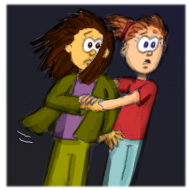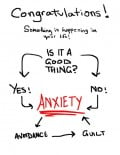- HubPages»
- Health»
- Mental Health»
- Anxiety Disorders
Understanding Fears
Fears Can Hold Us Back

Fear is ...
We have many emotions. Fear is a basic human emotion, one we can all relate to, and an emotion we have all felt. As our heart beats faster, we begin to sweat, our muscles tense, and our thoughts begin to race. Fear is an emotion that affects our entire body. The implications of experiencing fear, the mere thought of experiencing fear, and the memories our fears evoke cause us much distress.
Fear kick starts an entire series of bodily responses from our hearts beating faster, to racing thoughts, from sweating to tense muscles. It shows itself through physical manifestations, and becomes an entire body experience. Yet, fear all begins in our brains. We are hardwired to react to fear. It is programmed within our nervous system and works automatically, on instinct. Our survival is dependent on this emotion and we respond whenever we feel unsafe. From infancy to old age, fear is an intertwined part of us.
Sometimes fear is helpful and sometimes it is not. Fear is a warning bell that helps us prepare for a situation we have perceived may be threatening to us. Fear reactions can range from mild to very extreme. We have different reactions based on different situations. Each person reacts to fear based on their own personality, previous experiences, and current situation.
The perceived sense of danger makes our brain react, and activates our nervous system, which prepares our body for physical reaction. Our fear reaction is activated instantaneously and automatically. When our brain believes the danger has passed, all our bodily systems return to normal.
What Are Goosebumps?
When we perceive a threat or danger, our entire body, and mind get involved. When we feel threatened, the amygdala, alerts the rest of our body. The amygdala is responsible for controlling our responses to fear. It starts the secretion of hormones and helps form emotional memories. Once the hormones are activated, our body readies itself for the well known fight or flight response. When we don’t feel threatened any longer, the physiological effects go away, and we feel normal again.
Goosebumps is another one of these physiological reactions we have to stress. It is an ancestral vestige that doesn't really help us anymore, but was useful when we were covered with more hair. Goose bumps happen because we have mini muscles that are connected to each hair. When we feel threatened, stress hormones get activated and the hair elevates to make us appear bigger (if we had more hair on us). That is what makes it a vestige. We don’t need it anymore, it is a leftover from our more primitive days. You can see it more easily in cats when they arch their back and their stands up. By appearing bigger, the attacker may back off.
Fear is an interesting emotion because it is an entire body experience. Our brain processes the information. Our body responds and readies us for our protection, and survival. We are predisposed to sense threats and dangers and our whole body is sensitized to this perception. We have all experienced fear, and we can relate to this feeling. Have you ever met someone who has not been scared by something. The interesting thing about fear, is it doesn't have to be real.
If we believe there is something to be afraid of, we are. In fact people who have an anxiety disorder take longer for their bodies to get everything back to normal physically and psychologically. Science knows a lot about how fear is generated, but not as much about how our body and mind turns it off. Some research is pointing to compounds our body naturally produces that may influence the off ‘fear’ off switch. These naturally producing chemicals called endocannabinoid, which have similarities to marijuana ingredients. Mice who were devoid of this brain receptor were not able to regulate their fear.
More studies need to be done to prove this theory, although scientists have found that anandamide, one type of many cannabinoids does have a function in regulating our fear response. More research is being done to see if boosting these levels can fear responses in people who have higher levels of anxiety. Some studies in mice are proving that the rodents do in fact, recover from being afraid quicker when they modify this cannabinoid. With further studies, science may one day be able to help people who have anxiety disorders, panic attacks, and PTSD (post traumatic stress disorder).
Fear is so powerful an influence on our live, people have altered their lives in order to avoid situations that could stimulate the fear response. Many studies have shown that anxiety disorders and panic attacks have a strong genetic link. Researchers, have not yet been able to identify a fear gene or genes. Science has started to research the circuitry in our brain in the hopes that this will lead to to a trail that will point them in the direction of locating the DNA involved in gene expression.
In addition to fear of environment, and phobias, we also have fears of not yet experienced circumstances. Many people have a fear of failure. Fear of failure is an irrational thought process, that makes the person believe they will not succeed at what they are doing. People may get a feeling of insecurity about their future, they may feel they will upset others, doubt their competence, or they may devalue their own sense of self worth. Procrastination is often an outlet of the fear of failing. Fear of failure is an interesting topic too, for it holds us back in many ways, for many things, and for many reasons. What would each of us really do, if we knew we couldn't fail at it?
Fears Can Stop Us From Doing Things

The Five Basic Fears
Fear therefore, in addition to being a whole body experience, is a guiding and powerful force in our lives, shaping almost everything we do, everything we accomplish, and every experience we have. Think about the things you avoid because of fear. Think about the person you are because you took on the challenge and had the courage to face your fears. Think about the things you have avoided because of your fears.
What would you have done different, if you didn’t have fears. Would you have married someone different? Would you have chosen a different career? Would you live in a different place? Would you have different hobbies? Would you look different and act different? How has fear shaped your life and impacted who you are and what you do? Would you be more competent, more confident, more complete? How has fear protected you?
Fear is both an automatic and complicated response. There are many parts of our brain that play a role in our fear reaction - Thalmus, sensory cortex, hippocampus, amygdala, hypothalmus.
We react to fear in one of two ways. We can either be reactive, where the fight or flight response is activated, or we can have a thought oriented reaction. When we are reactive, we respond without even knowing what caused the fear. When we have a thought oriented response, we do our use our higher order of thinking to determine if the threat is real or not. A reactive response is more spontaneous. A thought oriented response takes longer to decide if we should be fearful or not, but we will often remain calmer,especially if there is no real threat.
There are five fundamental fears.
- We fear extinction.
- We have a fear of being harmed.
- We have a fear of losing our freedom.
- We have a fear of abandonment.
- We have a fear of being shamed.
Every fear we have can be put into one of these categories.
Has fear gotten in your way?
Has Fear Ever Stopped You From Doing Something You Wished You Had Done?
The Fears We Are Born With and The Fears We Learn
Fears stem from our need to survive. Some fears are learned responses. When we look at how our fears are stopping us from living, enjoying, experiencing, and thriving, we can unlearn some of these fears and help ourselves and gain more control over our lives. Some of our fears are hardwired within us, and stem from our evolutionary past. These fears are much harder to unlearn.
Edward L. Thorndike was a scientist who became influential in psychology in the late 1890’s and early 1900’s and became known for his work about how animals and humans learn. Martin Seligman, a psychologist in the 1970’s revived much of Thorndike’s theories. Seligman noticed that some phobias were more difficult to treat than other phobias. Fears of snakes, rats, and spiders were very common and very difficult to treat. Yet more people are harmed by getting electrical shocks from outlets, or hurt in automobile accidents than from these small creatures. Seligman proposed that these fears, and fears of enclosed places, fire,heights and water are innate fears that threatened our survival long ago. Nature made us predisposed to these fears. Modern things that can harm us, did not exist inevolutionary times,so our fears of them won’t exist in our mind, they only come about from learned behavior or observation.
Some Fears are Real, Some Fears are Irrational
Fear is a universal emotion, yet we all react differently. Some fears are real, some are irrational. We are predisposed to some fears, and some fears we learn. Some fears can lead to other problems, including anxiety and depression. Some fears get worse, and some we can get over. Fears will always exist in us and around us.
Fear is designed to warn us of impending danger, and without the ability to fear, we couldn't survive. Yet, we need to manage our fears, so that our activities and quality of life (QOL), is affected as little as possible. The more aware we are of ourselves, the more we can help ourselves deal with the fears we have.
Fears will always exist, but we can be bigger and better than the things that make us afraid. Fear exists in our minds, and fear can be conquered by our minds. Fear doesn’t have to stop us, it doesn't have to get in our way. The freedom from the fears that hold us back, allows us to believe that the best is yet to be.




